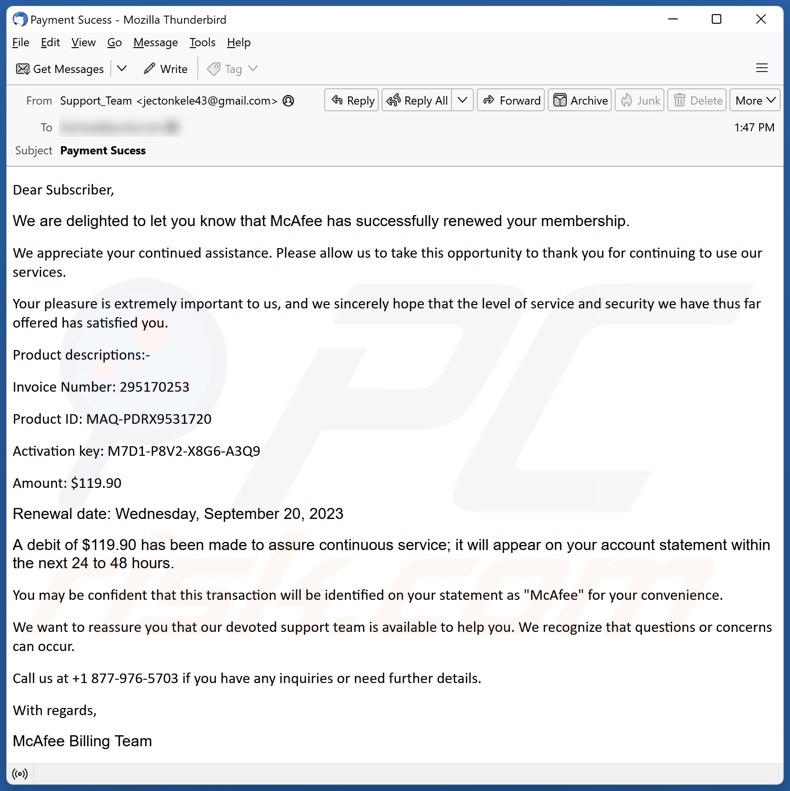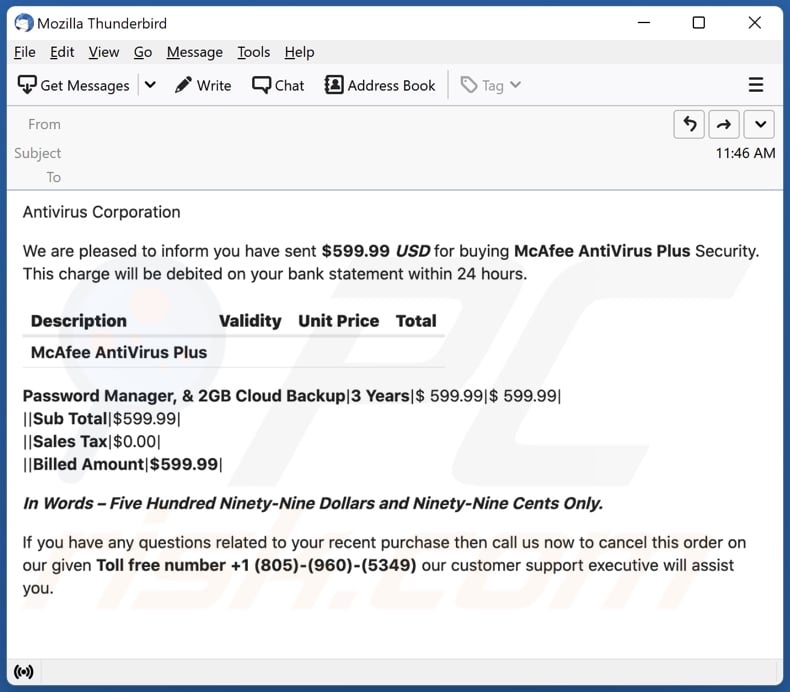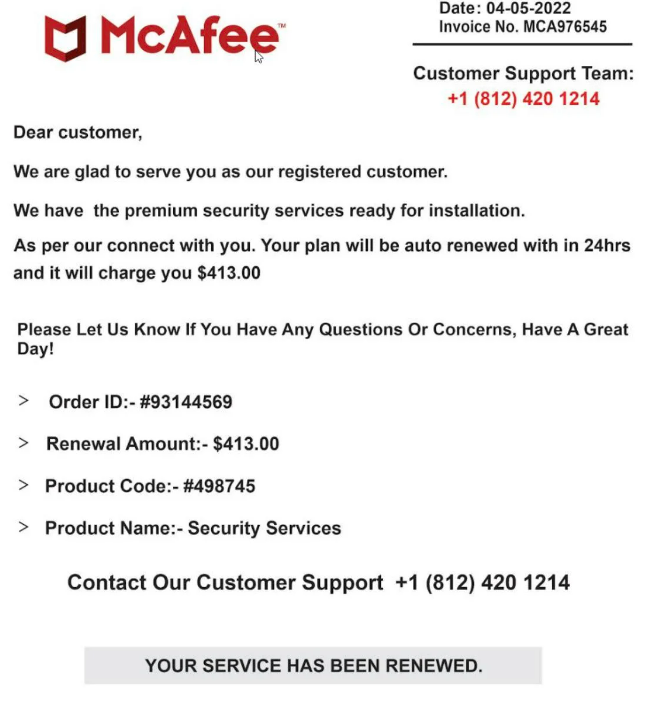Have you ever received an email that looks like it's from McAfee, but you're not sure if it's real?
You're not alone. Fake McAfee renewal emails are a common scam that can trick you into giving up your personal information or money.
Here's how to spot a fake McAfee renewal email:
Read also:Discover The Unseen Good Mythical Morning With Stevie
- The email address the email is from is not a McAfee email address.
- The email contains typos or grammatical errors.
- The email asks you to click on a link to renew your subscription.
- The link in the email takes you to a website that looks like the McAfee website, but it's not.
- The website asks you to enter your personal information or credit card number.
If you receive an email that looks like it's from McAfee, but you're not sure if it's real, don't click on any links or open any attachments. Instead, forward the email to McAfee at phishing@mcafee.com.
You can also report the email to the Federal Trade Commission at ftc.gov/complaint.
Fake McAfee Renewal Email
Spotting a fake McAfee renewal email is crucial to protect your personal information and finances. Here are seven key aspects to consider:
- Sender's Email Address: Not a McAfee email address.
- Typos and Errors: Typos or grammatical errors in the email.
- Renewal Link: Asks you to click a link to renew your subscription.
- Phishing Website: Link takes you to a website that imitates McAfee's but is not genuine.
- Personal Information Request: Asks for personal information or credit card number.
- Suspicious Attachments: Avoid opening attachments as they may contain malware.
- Report and Forward: Report suspicious emails to McAfee and the FTC.
These aspects help identify fake McAfee renewal emails. If you encounter an email with any of these red flags, do not engage and report it promptly. Protecting yourself from these scams ensures online security and prevents potential financial loss.
1. Sender's Email Address
The sender's email address is a crucial indicator of a fake McAfee renewal email. Legitimate emails from McAfee will always come from an official McAfee email address. If the email you receive appears to be from McAfee but the sender's email address is not a McAfee email address, it is likely a phishing attempt.
- Identifying McAfee Email Addresses
McAfee email addresses typically follow the format username@mcafee.com. If the sender's email address does not match this format, it is likely fake.
Read also:
- Explore The Enchanting Dunalastair Castle A Timeless Gem
- Checking for Common Phishing Email Addresses
Phishing emails often use common email addresses such as noreply@example.com or support@example.com. If the sender's email address is a generic one like this, it is more likely to be fake.
- Looking for Typos and Errors
Phishing emails often contain typos or grammatical errors. If the sender's email address has any typos or errors, it is a red flag that the email may be fake.
- Trusting Your Instincts
If something about the sender's email address doesn't feel right, trust your instincts and don't click on any links or open any attachments.
By being aware of the importance of the sender's email address and by checking for the indicators listed above, you can help protect yourself from fake McAfee renewal emails.
2. Typos and Errors
Typos and grammatical errors in emails can be a sign of a fake McAfee renewal email. This is because phishing emails are often created by scammers who are not native English speakers or who are trying to create a sense of urgency to trick you into clicking on a link or opening an attachment.
For example, a fake McAfee renewal email may contain typos such as "McAfee" being spelled as "McAfee" or "subscription" being spelled as "subsciption." It may also contain grammatical errors such as "Your subscription will expire soon" instead of "Your subscription will expire soon." These errors are often a sign that the email is not legitimate.
It is important to be aware of the connection between typos and errors and fake McAfee renewal emails. By being aware of this, you can help protect yourself from phishing scams and keep your personal information safe.
3. Renewal Link
A key component of fake McAfee renewal emails is a "Renewal Link" that asks you to click to renew your subscription. This link is often the central element of the email, designed to trick you into taking an action that could compromise your personal information or financial security.
When you click on the renewal link in a fake McAfee renewal email, you are typically taken to a phishing website that looks like the real McAfee website. This website may ask you to enter your personal information, such as your name, address, and credit card number. It may also ask you to download software or click on other links that could infect your computer with malware.
It is important to be aware of the dangers of clicking on renewal links in unsolicited emails. If you are not sure whether an email is legitimate, do not click on any links or open any attachments. Instead, forward the email to McAfee at phishing@mcafee.com and report it to the Federal Trade Commission at ftc.gov/complaint.
By understanding the connection between renewal links and fake McAfee renewal emails, you can help protect yourself from phishing scams and keep your personal information safe.
4. Phishing Website
Phishing websites are a common component of fake McAfee renewal emails. These websites are designed to look like the real McAfee website, but they are actually controlled by scammers. When you visit a phishing website, you may be asked to enter your personal information, such as your name, address, and credit card number. You may also be asked to download software or click on other links that could infect your computer with malware.
- How to Spot a Phishing Website
There are a few things you can look for to spot a phishing website:
- The website address may be similar to the real McAfee website, but it will not be exactly the same.
- The website may have a different design than the real McAfee website.
- The website may contain typos or grammatical errors.
- The website may ask you to enter personal information that McAfee would not normally ask for, such as your Social Security number or your credit card number.
- What to Do If You Visit a Phishing Website
If you visit a phishing website, do not enter any personal information. Instead, close the website and report it to McAfee at phishing@mcafee.com.
By understanding the connection between phishing websites and fake McAfee renewal emails, you can help protect yourself from phishing scams and keep your personal information safe.
5. Personal Information Request
One of the most common red flags of a fake McAfee renewal email is a request for personal information or credit card number. Legitimate companies will never ask for this information via email. If you receive an email that appears to be from McAfee and it asks for this information, it is likely a phishing scam.
- Why Scammers Ask for Personal Information
Scammers ask for personal information for a variety of reasons, including:
- To steal your identity
- To access your financial accounts
- To sell your information to other criminals
- How to Protect Yourself
There are a few things you can do to protect yourself from phishing scams that request personal information:
- Never click on links or open attachments in emails from unknown senders.
- Be wary of emails that ask for personal information, even if they appear to be from legitimate companies.
- If you're not sure whether an email is legitimate, contact the company directly.
By understanding the connection between fake McAfee renewal emails and requests for personal information, you can help protect yourself from phishing scams and keep your personal information safe.
6. Suspicious Attachments
In the realm of "fake McAfee renewal email" scams, suspicious attachments stand as a significant threat, posing risks to unsuspecting users. These emails often come with attachments that appear legitimate but are carefully crafted to deliver malware onto your device.
- Malware Delivery Mechanism
Attachments in fake McAfee renewal emails often contain malware, which can infect your device upon opening. Malware can range from viruses that corrupt your system to ransomware that encrypts your files and demands payment for their release.
- Deceptive Disguise
These attachments may be disguised as invoices, receipts, or other seemingly harmless documents. By using familiar file formats and naming conventions, scammers attempt to trick users into opening them without suspicion.
- Exploiting Vulnerabilities
Malware attached to fake McAfee renewal emails can exploit vulnerabilities in your software or operating system. By taking advantage of these weaknesses, malware can gain access to your device and compromise your security.
- Consequences of Infection
Opening a malicious attachment can lead to a range of negative consequences, including data loss, financial theft, and identity theft. It is essential to remain vigilant and avoid opening attachments from unknown or suspicious sources.
Understanding the connection between suspicious attachments and fake McAfee renewal emails empowers you to protect your devices and personal information. By exercising caution and practicing safe email habits, you can mitigate the risks associated with these deceptive scams.
7. Report and Forward
The connection between "Report and Forward: Report suspicious emails to McAfee and the FTC" and "fake McAfee renewal email" is vital in combating phishing scams and protecting personal information.
Fake McAfee renewal emails are designed to deceive recipients into giving up sensitive data or financial information. By recognizing the signs of these malicious emails, individuals can actively report them to McAfee and the Federal Trade Commission (FTC).
Reporting suspicious emails serves several purposes:
- Assists McAfee in identifying and blocking phishing campaigns: Reporting fake emails to McAfee helps the company identify phishing patterns and take appropriate actions to protect its customers.
- Strengthens FTC's database for combating fraud: The FTC maintains a database of reported phishing emails, which aids in investigating and prosecuting fraudulent activities.
- Raises awareness and educates the public: Reporting suspicious emails contributes to raising awareness about phishing scams and educating the public on how to avoid becoming victims.
Forwarding suspicious emails to McAfee and the FTC empowers individuals to participate in the fight against cybercrime. By promptly reporting these emails, they help strengthen defenses against phishing attacks, protect themselves and others from potential harm, and contribute to a safer online environment.
Frequently Asked Questions about Fake McAfee Renewal Emails
This FAQ section provides answers to common questions and concerns regarding fake McAfee renewal emails, empowering users to recognize and protect themselves from these malicious attempts.
Question 1: How can I identify a fake McAfee renewal email?
Fake McAfee renewal emails often exhibit telltale signs such as sender email addresses that differ from official McAfee domains, grammatical errors or typos in the email body, urgent calls-to-action, suspicious attachments, and requests for personal or financial information.
Question 2: What should I do if I receive a fake McAfee renewal email?
Upon receiving a suspicious email claiming to be from McAfee, refrain from clicking on any links or opening attachments. Instead, report the email to McAfee at phishing@mcafee.com and forward it to the Federal Trade Commission (FTC) at ftc.gov/complaint.
Question 3: What are the consequences of opening a fake McAfee renewal email?
Opening a fake McAfee renewal email can expose your device to malware infections that may steal sensitive data, compromise your financial accounts, or disrupt system functionality. It can also lead to phishing attacks that attempt to trick you into revealing personal information or providing access to your financial resources.
Question 4: How can I protect myself from fake McAfee renewal emails?
To safeguard yourself from fake McAfee renewal emails, exercise caution when opening emails from unknown senders, avoid clicking on suspicious links or attachments, use antivirus software to detect and block malicious content, and keep your operating system and software up to date with the latest security patches.
Question 5: What should I do if I have already provided my personal information in response to a fake McAfee renewal email?
If you have inadvertently disclosed personal information due to a fake McAfee renewal email, promptly contact your bank or credit card companies to report any unauthorized activity. Consider changing your passwords and monitoring your financial accounts closely for suspicious transactions.
Summary: Recognizing and reporting fake McAfee renewal emails is crucial to protect yourself from phishing scams and online threats. By understanding the common tactics used by scammers and taking proactive measures, you can mitigate the risks associated with these malicious emails and safeguard your personal information.
Transition to the next article section: For further insights into protecting yourself from cyber threats, explore our comprehensive guide on online safety and security.
Conclusion
In conclusion, "fake McAfee renewal email" scams pose significant threats to unsuspecting individuals and organizations. Understanding the tactics employed by scammers and recognizing the red flags associated with these malicious emails is critical to safeguard personal information and financial security.
By educating ourselves, reporting suspicious emails, and adopting proactive cybersecurity measures, we can collectively combat these phishing attempts and protect the integrity of the digital landscape. It is through vigilance and collaboration that we can create a safer and more secure online environment for all.


